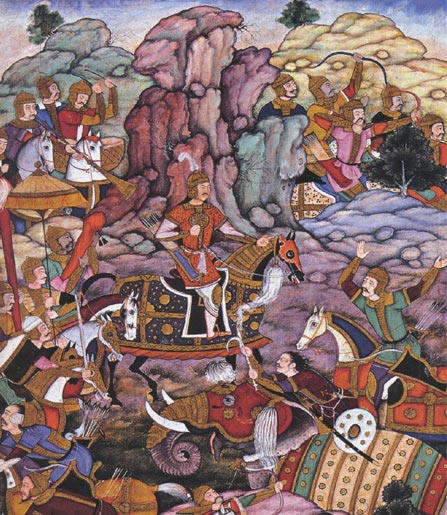First Panipat
Though almost all sources give Babur's army at First Panipat as 12,000, Stewart Gordon [1] notes that Babur himself never counted his army. He is reckoned to have between 10-20,000 soldiers at this time; before the battle he is supposed to have said he had fewer men than he thought. Against that, intriguingly, Gordon notes that the army might have included locally recruited matchlock men. Should these be counted as part of the estimated 12,000, or were they extra? We do not know.
Ibrahim Lodhi's army of Afghans is usually given as 100,000. To exaggerate the adversary's strength was, however, common practice.
The conventional view emphasizes Babur's artillery as the reason for his victory. Lodhi was deficient in this important arm, with a shortage both of tubes and of ammunition. Yet Gordon disagrees this was a factor because Babur had few guns.
In our opinion, four factors may be considered as critical in Babur's victory. The last we will discuss later.
Equality of commanders and men
Thanks to his years of wandering, Babur had completely equal relations with his men. Anyone could eat at his table, and anyone could give his opinion on strategy and tactics. Babur's foremost concern was looking after his men. This trait of equality between all elements must have been a powerful "force multiplier" in Babur's favor compared to Ibrahim's traditional feudal army with all its distinctions between men.
Losing was not an option
Babur's men had followed him through thick and thin for almost 30 years. Sometimes he was down to a few hundred soldiers because he could not afford to keep more. The army that took Panipat had no place to return to: Babur was in the middle of hostile territory, any retreat would have been attacked by the petty kings and chieftains who had let him pass, largely unopposed. We may assume their restraint was brought with promises of reward after victory; should Babur fail, there was no need for the locals to keep their word. Also, even those that survived to get back to Ferghana might well find they had no kingdom to return to: Babur had on many occasions lost his throne, the force he left behind - if any - could not have numbered more than several hundred or a few thousand. Should Babur's star be dimmed by defeat at Panipat, his enemies back home would surely have been emboldened to dethrone him yet again. Men with their no line of retreat have no choice but to advance: retreat means certain death.

PANIPAT 1526
http://www.columbia.edu/itc/mealac/pritchett/00routesdata/1500_1599/babur/panipat/panipat.html
Tactics
Indian armies of the day - and longer before and long after - had a single tactic: mass and meet the adversary head on, brute force making up for finesse.
It can be argued that given the way the armies were assembled, the uneven nature of training, arming, and background of the troops, this "at them and straight down the middle" approach made the best sense. There is also a case to be made that this was the characteristic of Indian armies, and it grew out the people's nature. It used to be said, even in the last days of the British empire, that troops like the Baloch, the Pathans, and the Sikhs were absolutely fearless and even reckless in the attack. But any setback caused them to lose heart and could lead to unnecessary defeat. It seems this was pretty much anyone approached war in South Asia.
Babur, however, did something extraordinarily clever. He created a static defense line based on the town of Panipat to protect one flank, and a wide-ditch filled with brush. Then a barrier composed of bullock carts, many requisitioned from the area, was created in front of the static defense line. The carts were tied together, but had openings through which the cavalry could charge.
Gordon assumes his few guns opened fire on the advancing Afghans, led by their elephants, and unleashed his cavalry to move around and behind the Afghan forces. The latter was organized, as usual for those times, in a single phalanx. Babur's cavalry squeezed the Afghan phalanx so that it could neither advance, nor outflank, nor retreat. The entire phalanx fell into what is today called a "kill zone", and was destroyed by falling on itself, largely because of its inability to maneuver.
Today the hammer and anvil method is so standard as a battlefield tactic that we may justifiably wonder what all the fuss was about. But...
Because armies at the time had no staff officer system, and no communications worth the name, it was extraordinarily risky to try anything except the straight assault. If the cavalry had not succeeded in encircling the Afghans, or if the anvil - the barriers - had not held, there would have been no Mughul empire. The outflanking move required exquisite timing and perfection, given Babur had so few troops to begin with, and so would have been unable to construct a meaningful reserve. And in any case, without good intra-army communications, how was the reserve to deploy to where it was needed most?
Weapons
If you consider Babur's cavalry's main weapon, it was neither lance nor sword. It was a powerful double-curved bow. Babur's cavalry could fire on the move - without mixing it up with the adversary forces. Undoubtedly the Mongol influence played a large influence in the development of this weapon.
TO BE CONTINUED
References
[1] http://college.hmco.com/history/readerscomp/mil/html/mh_005200_babur.htm